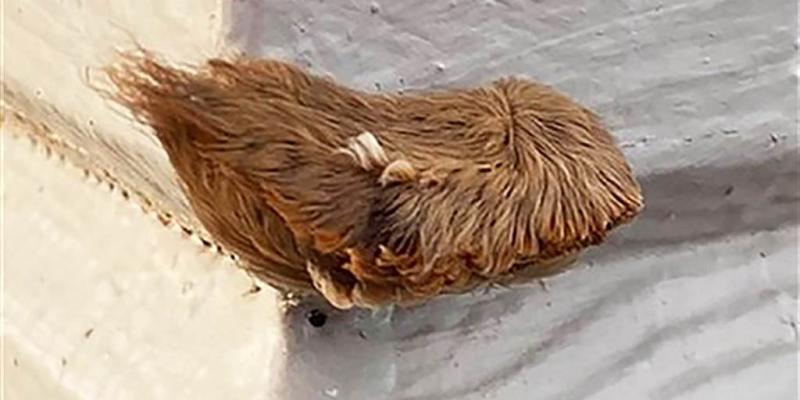Forestry officials warn to 'social distance' from hairy-looking caterpillars



Attention Virginia residents! Beware the fluffy and hairy-looking caterpillar that has been crawling around the eastern part of the state.
The puss caterpillar, which transforms into the southern flannel moth when it becomes an adult, may resemble a tiny toupee, but it's actually one of the most venomous caterpillars in the United States according to a profile by Donald W. Hall, professor emeritus of University of Florida's Entomology and Nematology Department.
The Virginia Department of Forestry has been receiving reports of recent sightings and issued a warning on Tuesday with a photo of one of the caterpillars. The department told Virginians in a Facebook post to "#SocialDistance away from this caterpillar!
"The 'hairs' of this caterpillar are actually venomous spines that cause a painful reaction if touched. The caterpillars eat oak and elm leaves, but they can be found in parks or near structures."
Within the caterpillar's spines is a venom gland at the base. A person who has been stung may experience burning pain that is followed by a red pattern on the skin, similar to the arrangement of the venomous spines on the caterpillar. Hall also wrote that in addition to localized symptoms, headache, fever, nausea, vomiting and low blood pressure may also occur depending on the severity of the sting. If you are stung, experts recommend calling your doctor and using tape to remove any broken spines from your skin.
In its post, the Virginia Department of Forestry advises, "If you find the caterpillar, leave it alone and let its natural enemies control their populations— there are a number of other insects that will prey on them at different stages of their life cycle."
The puss caterpillars vary in size from 1.2 to 1.4 inches and are typically found in southern states such as Virginia, but are most common in Arkansas, Florida, and Texas.
Dr. Tim Kring, the head of the Department of Entomology at Virginia Tech, told TODAY that while Virginia is in the northern range of where it commonly occurs, it's "not unusually numerous" this year.
"Like all insects, you'll have a year where there's more of them one year and less the next," he said. "We might be in a little bit of a more (year), but it's certainly not an unusual year at all for us."
So why are Virginians coming across these caterpillars more often in recent months?
"In the fall, they're getting ready to turn into moths and they'll drop to the ground and pupate," Dr. Kring explained. "And that's when you'd probably see them. It's called the wandering stage where they're getting ready to turn into the moth."
Ren Oliver encountered a puss caterpillar last month in Tappahannock, Virginia.Courtesy of Ren Oliver
Ren Oliver, 38, from Harrisonburg, Virginia, had a near brush with one of the caterpillars on Sept. 2 while she was enjoying a family dinner outside.
"We were sitting outside on the deck eating dinner in Tappahannock, Virginia," Oliver told TODAY via e-mail. "My 5-year-old son saw it and said 'Don't anyone touch it! It's probably poisonous!'"
Oliver continued, "Since then, I've heard of two people getting stung by them and heard it was excruciating. Thankfully, we escaped it but it was the wildest-looking thing and so appropriate for 2020."
While this species isn't invasive and doesn't target humans, if you come across a puss caterpillar when you're exploring outside, it's best not to interact with it.
"I would say, leave them alone," Dr. Kring said. "They're not considered a pest to plants, so there's no reason to kill it. They don't prefer to be near humans. Once they find that place (to pupate), then you won't see them anymore."
Francesca Gariano






Interesting question: Will Trumpists consider distancing from these caterpillars to be an infringement on their freedom?
But I'm pretty sure that shooting and stomping them will be OK.
o-o-o-o-o... that would be s-o-o-o cool...
Like stomping on a mass of super-powerful poison ivy...
You've never been stung by one, have you? A jellyfish sting is more comparable.
I can tell you that it hurts like Hell! It not only stings, but, burns as well. Being stung by one is something you never forget.
I don't know this particular species.
My wife and I used to run on trails in a nearby forest. We noticed "bundles" hanging from trees. Public service announcements on the radio warned us not to touch... not even to go near.
Apparently, our "far away" wasn't far enough. We both got weeping rashes all over.
In Texas, we call them 'asps'. I was stung/speared/tased/bitch-slapped by one when I was 8 or 9. I highly unrecommend it.
Same here. I was sitting under a tree out on the school grounds in grade school, when I suddenly felt a very hot 'sting' on my neck. I wasn't sure what it was so I ran in to the school nurses' office and showed her. She said it was a tree asp, but, very dangerous. She carefully took the asp off my neck and put it in an envelope. Then called my Mother who took me to our family Doctor. By that time I was feeling sort of woozie, and the place on my neck was very swollen and bright red.
By the time we reached the Doctor's office my Mother had to help me walk in, and the Nurse put me in a room right away. The Doctor came in very soon and my Mother showed him the asp and seeing the reaction I was having he gave me two shots and gave me some medicine to take at home. I was sick for 4 days, and the plalce on my neck where the thing stung me turned into a boil. No fun that either.
This happened when I was in the second grade in Ft Worth TX.
At least we now know where Trump got his hair from.